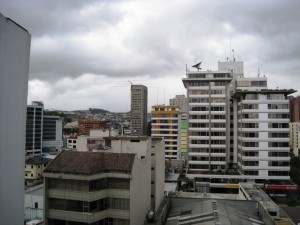Panama Canal Transit — Part II
After getting the boats rafted up, we drove into the first lock behind a container ship. Basically, the drill is as follows: the middle boat captain (i.e. me) drives the boat into the middle of the lock (we had probably 15 feet to spare on either side so this wasn’t particularly tough but did require paying constant close attention) and then the Canal personnel throw long lines with monkey-fists on the ends to the linehandlers on the outside boats (two to each side for a total of four). The four linehandlers then hold the whole raft in place, keeping it from drifting too far to either side or spinning. When the lock fills up with water, the linehandlers take in the slack as the boats rise. When the lock empties, the linehandlers let out slack as the boats go down.
This is not a tough job, but, for the forward linehandler on the French/Dutch boat on our left, it apparently was tantamount to splitting the atom. This guy was a complete fool. Every couple of minutes, the raft would begin rotating clockwise, I’d look to the bow of the left boat, and the guy on the bow would be standing there with a slack line running though his fingers. I mean, really … a six-year-old girl could do this job. I’d yell at him, he’d begin taking in the line, the raft would straighten, and, three minutes later, the process would repeat itself.
Needless to say, none of us aboard Spectacle were even slightly amused. At one point (after a particularly heated exchange), one of the Frenchmen aboard the left-side boat said something lippy to Ian, who responded (without missing a beat), “Hey, didn’t you guys try to build this thing once?” It was pure genius.
The right side boat (aka the humorless Germans) weren’t much better. Mostly, they lounged about the cockpit eating various hot meals brought up from below while their captain decided to engage in his own raft-steering regime (against the instructions of the advisors and making my job more difficult). But their best moment came when it was time to break up the raft for the first time. As we released the lines tying the boats together, their captain brilliantly decided to simultaneously floor it and make a hard right turn, swinging the stern of his boat into us. An incredulous but extraordinarily alert Melissa grabbed the boat hook and began trying to fend him off, putting the (plastic) hook onto his (metal, non-aesthetic) stern cleat and pushing with all her might. Again, the non-scratching plastic was on their cleat, needed to be there, and the guy was driving like an idiot.
Well, the guy reacted like she was keying his car. “Do NOT use zee boat hook!” he screamed. OK, dude, do not drive zee stern of your boat into us…
By this point, we had completely had it with both the other boats. So, for the rest of the transit, we basically treated them like six-year-olds and barked orders. I’m sure they hate us. Believe me, the feeling is mutual.
Aside from our chilly relationship with the other raft members, the transit was really fun. We went through the Gatun locks in darkness on the evening of the 19th before Meza was picked up by a launch and the remaining five of us spent the night on a mooring buoy (hard to call it a “ball” since it was about four feet across and Erik had to stand on it to tie us up). I cooked up some of my ersatz shrimp creole (which is now approaching semi-official “Dish of Spectacle” status), we had a few Balboas and headed to bed, awaiting Meza’s promised 7:00 a.m. arrival back at the boat.
Meza was right on time, and off we went through Gatun Lake. It was a blessing to be able to spend most of the day free from our NATO allies as we motored through this beautiful and strange creation. Eventually, we reached the brown water and high walls of the Gaillard Cut before rerafting with the Europeans to pass through the Pedro Miguel Locks and, finally, the Miraflores Locks. We sailed under the Bridge of the Americas at around 3:15 p.m. Melissa raced up to the front of the boat so she could be first one into the Pacific Ocean.
Our total transit time was about 12 hours (four hours the first night and eight hours the second day).
We had visited the Canal before and, to be honest, were kind of disappointed. From the observation deck at Miraflores, it sort of looks like a suburban street that happens to be filled with water – not very dramatic. But going through it, one far better realizes the sheer magnitude of the engineering project and just what a wonder it is. It was a very cool experience, not particularly stressful (except for our raftmates), and something we are very happy to have done.


